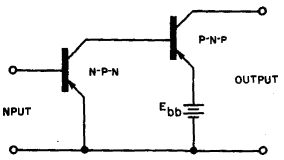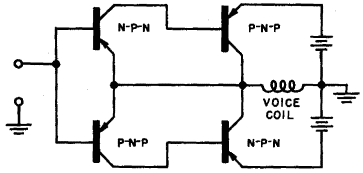| Transistor Basics is a free introductory textbook on transistors and their basic applications. See the editorial for more information.... |

|

Home  Transistor Amplifiers Transistor Amplifiers  Complementary-Symmetry Circuits Complementary-Symmetry Circuits  Cascade Operation Cascade Operation |
||






|
||
|
Cascade OperationAuthor: Leonard Krugman
Fig. 5-23. A direct-coupled symmetrical cascade. One type of symmetrical circuit that proves very practical is the cascaded arrangement illustrated in Fig. 5-23. This tandem circuit represents the simplest possible cascade, since the only components of the system are the transistors and the battery supply. The gain per stage is low compared to the maximum available gain because of the mismatch existing between the stages. However, the reduced number of components and the simplicity of the design often outweighs this disadvantage.
Fig. 5-24. Two-stage symmetrical push-pull amplifier.
It is apparent that complementary-symmetry circuits offer considerable promise for further investigation. Their use in the field of high quality, low-cost portable audio systems is particularly attractive because the output can be fed directly into a voice coil, thus eliminating the expensive and often troublesome output transformer.
|
||
Home  Transistor Amplifiers Transistor Amplifiers  Complementary-Symmetry Circuits Complementary-Symmetry Circuits  Cascade Operation Cascade Operation |
||
Last Update: 2010-11-17



